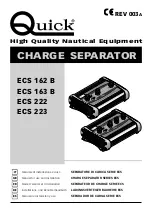
7.0.
DETERMINE THE BEST PIPE RUN FIRST
COORDINATE THE PIPE RUN WITH THE BEST SOUTH FACING COLLECTOR LOCATION
FOR THE SHORTEST RUN.
IMPORTANT: SLOPE all lines to DRAIN! As one
form of freeze protection of your SRCC OG300
rated system is draining the collectors, it is
important that all pipes between the collectors
maintain a 1/4" per foot drop to prevent water
traps and assure that all water drains when the
drain valves are opened on the "Quick Connect".
COMMON RUNS
In many one-story homes, the run is a simple matter of
going up into the garage rafter area and to the roof or
going through a wall or ceiling into the attic.
Common pipe runs to the basement include runs
adjacent to air return chases, plumbing and vent lines
and through closets.
In a two story house runs can
be challenging; however often a good solution is at
hand.
Consult with an experienced solar installer if
challenged with the installation.
CHASES:
Look for pipe, fireplace and duct chases
with room around them. The pipes can often be
dropped down next to a duct, especially in a one-story
house, in just a few minutes.
CLOSETS:
Sometimes the easiest way to run the
pipes is through closets (look for "stacked" closets in a
two-story house). Since 1/2” copper pipes are fairly
flexible, drilling through even many shelves with an
angle drill is easy as alignment does not have to be
precise.
NOTE: Copper pipes get harder, even brittle with
multiple bending, bend your pipe as little as
possible for the easiest installation! Unroll the soft
copper in smooth even strokes and be sure the
connections for the collector are above the roofline
so no water could get into the house if the
connection leaks.
DRYWALL:
It is sometimes necessary to cut
drywall at the floor or ceiling level in order to cut the
holes in a fire stop. Usually this hole can be made out
of sight in a closet. After sealing the firestop, it may
be desirable to make the remaining drywall removable
by putting a simple frame around it and placing it
back in place with a few finish nails.
INFILTRATION AND FIRE STOPS:
In all
situations, remember that infiltration is one of the
main sources of energy loss in a house. In no way
should the installation of a solar system contribute to
this loss! ALWAYS seal up any holes made in the
house envelope especially in the attic and fire stops.
Fire stops must be properly put back in place so their
important function is preserved.
STORAGE:
You need a storage tank that is at least
50 gallons with a one and two collector system and at
least 80 gallons with the three collector SRCC system.
You will need room to work around it and space for
the solar hardware, usually a foot on the drain side of
the heater is adequate.
You will need to turn the 220
volt power to the tank element off at the Breaker to
the tank. Be Sure to mark it with a label "Do Not
Turn On" for protection until you are completely
finished.
Competely drain the tank, remove the old
drain and install the tank "Quick Connect"
components.
The larger the water heater the better. For larger
families, or for situations where there is a small water
heater, adding a low cost 50-gallon or larger water
heater and using it only for the solar can be a good
idea. Plumbing will be required. SRCC OG300, rated
systems must have their lower elements disconnected.
Have
a qualified person
disconnect the lower
element. You will then only be using the top element
for backup. If this does not work well during the
winter, first try using water efficiency such as low
flow showerheads and aerators and/or have a
qualified person
add a 220v switch to the bottom
element.
Another good plan is to have a
qualified person
install a 220v timer set to heat the water for two hours
before you get up in the morning and for two hours
before you get home from work. Try turning the
power off during sunny summer days. You should
have ample Hot water with 1 panel for a family of 1-3
and with 2 panels for a family of 4 or 5 on clear
summer days.
INSULATION OF EXPOSED COPPER PIPES IS
NEEDED.
A MINIMUM 3/4” R-4.5 OR BETTER
High Temperature open cell insulation IS REQUIRED
for SRCC OG300 systems.
Summary of Contents for Fireball 20014
Page 2: ......












































